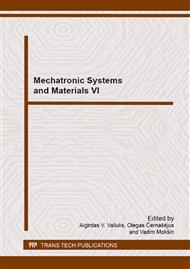p.3
p.9
p.15
p.21
p.27
p.33
p.37
p.43
Analysis of the Dynamic Properties of the Mechatronic Integrator of Control Procedures of the Vehicle Driven by Persons with Disabilities
Abstract:
The simulator of behavior of a disabled person driving the car is especially useful equipment. Mainly, the hands and the face of a driver are observed in order to determine facial expressions, slow-motion of the head and eyes, which according to the description of the simulation indicate disturbances of concentration and, in extreme cases may lead to nausea, or even loss of consciousness [1]. So, in the realization phase of the configuration the control system, the need to maintain high standards of safety was taken into consideration. The main problem described in the paper was measuring the acceleration and frequency of vibration during the operation of the simulator [2, 3, 4]. This analysis will help to determine whether any particular circumstances during crash simulations do not exceed the acceleration limit while the driver still feels its effects. It is also important to examine the frequency of vibrations, which during long driving simulator can cause nausea, dizziness or loss of consciousness. This analysis is a part of widely applied CAx analysis performed using special computer platforms that should be properly organized [5] and helps to expand the range of investigations [6].
Info:
Periodical:
Pages:
3-8
Citation:
Online since:
January 2015
Keywords:
Price:
Сopyright:
© 2015 Trans Tech Publications Ltd. All Rights Reserved
Share:
Citation:


